 Image search results - "kokyo" Image search results - "kokyo" |

In Japanese, the Imperial Palace is called "Kokyo" (皇居). This term begun to be used from 1948. Until then, it was called "Kyujo" (meaning palace castle 宮城)from the time Emperor Meiji took up residence.
|
|

Nijubashi Bridge, the symbol of the Imperial Palace and Tokyo. One of Japan's most famous bridges. There is another bridge behind this one. 二重橋
|
|
|
|
|
|
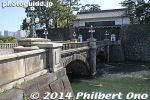
Rear of Nijubashi Bridge.
|
|
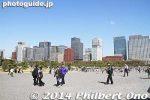
View of Marunouchi office buildings from Imperial Palace.
|
|

View from Nijubashi Bridge. The public can cross the bridge on the Emperor's Birthday (Dec. 23) and Jan. 2 for New Year's.
|
|

Crossing Nijubashi Bridge to enter the Seimon Gate. 正門
|
|

Fushimi Turret as seen from Nijubashi Bridge. Edo Castle was first built by Ota Dokan (太田道灌) in 1457 when Tokyo/Edo was still a small fishing village. Ota Dokan is thus regarded as one of Tokyo's forefathers. 伏見櫓
|
|
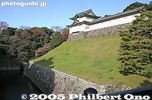
Fushimi Turret. This is what you see when you see Nijubashi Bridge. No one lives in this building. The Emperor's actual residence is not visible from the outside. 伏見櫓
|
|

The Imperial Palace's Chowaden Hall where formal banquets and meetings are held. This modern complex was built in 1968. In front is the Kyuden Totei plaza 長和殿、宮殿 東庭
|
|
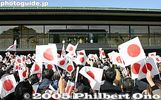
The Emperor and Empress appear on the veranda of this building on his birthday (Dec. 23) and Jan. 2. Well-wishers wave flags in the Kyuden Totei plaza. Also see the video at YouTube.
|
|
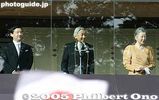
Crown Prince Hiro, Emperor Akihito, and Empress Michiko behind bulletproof glass on the veranda of the Chowaden Hall on the Emperor's Birthday. See more [url=http://photoguide.jp/pix/thumbnails.php?album=158]photos of the Emperor's birthday[/url
|
|

At one end of the Chowaden is Kitakuruma-yose entrance for Japanese dignitaries. 北車寄
|
|

Japanese flag and Fujimi Turret
|
|

Fujimi Turret 富士見櫓
|
|
|

Fujimi Turret, Edo Castle 富士見櫓
|
|

Fujimi Turret. Since Edo Castle had lost its castle tower which was never rebuilt, this turret served the functions of a castle tower. 富士見櫓
|
|
|
|

Imperial Household Agency is the government agency which controls and manages the affairs of the Imperial family (Emperor, Empress, etc.). 宮内庁
|
|

Map of the East Gardens of the Imperial Palace
|
|

Moat
|
|

Fujimi Turret 富士見櫓
|
|

Fujimi Turret 富士見櫓
|
|

Fujimi Turret 富士見櫓
|
|

Fujimi Turret 富士見櫓
|
|
|
|
|

Fujimi Turret 富士見櫓
|
|
|

Behind Fujimi Turret 富士見櫓
|
|

Behind Fujimi Turret
|
|

Moat
|
|
|

Honmaru, Edo Castle's main keep. See the castle tower's foundation on the lower right. 本丸
|
|

Castle tower's foundation on the lower right.
|
|

The original castle tower or donjon was completed in 1607 and later renovated in 1638 under Shogun Tokugawa Iemitsu as Japan's tallest castle tower at 58 meters (5 stories high).
|
|

Foundation of castle tower or donjon. In 1657, there was a great fire in Edo and a stray ember set the castle tower on fire and destroyed it only 19 years after it was built. It was never rebuilt. 天守台
|
|
|
|

Going up the castle tower foundation.
|
|
|
|
|
|

Going up the castle tower foundation.
|
|
|

View from castle tower foundation.
|
|

Top of castle tower foundation.
|
|

View of Kitahanebashi-mon Gate
|
|
|
|

Side view of castle tower foundation.
|
|

Corner of castle tower foundation.
|
|

Corner of castle tower foundation.
|
|

Moat behind castle tower foundation.
|
|

Moat as seen from Kitahane-bashimon Gate
|
|

Kitahane-bashimon Gate. Right behind the castle tower foundation. 北桔橋門
|
|

Otemon Gate, Edo Castle's main gate. 大手門
|
|
|
|
|
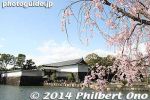
Weeping cherry blossoms near Otemon gate.
|
|
|
|
|
|

Otemon Gate 大手門
|
|

Otemon Gate 大手門
|
|
|

Doshin Bansho Guardhouse where guards kept watch on the entourage of daimyos visiting the castle. 同心番所
|
|

Hyakunin Bansho Guardhouse where 100 samurai guards guarded the entrance to the Honmaru, the castle's main keep. 百人番所
|
|
|

Daibansho Guardhouse 大番所
|
|
|
|
|
|

View of Hakucho moat from Shiomizaka Slope 汐見坂 白鳥濠
|
|
|
|

Tatsumi Turret 翼櫓(桜田二重櫓)
|
|

Tatsumi Turret 翼櫓(桜田二重櫓)
|
|
|

Tatsumi Turret, also called Sakurada-Niju Turret 翼櫓(桜田二重櫓)
|
|
|

Tatsumi Turret was used for defense with holes to drop stones and windows to shoot arrows. 翼櫓(桜田二重櫓)
|
|
|
|
|
|

桔梗門
|
|
|
|
|

Sakashita-mon Gate 坂下門
|
|

Sakashita-mon Gate, closest to the Imperial Household Agency and entrance to Inui-dori, a 600-meter path lined with cherry blossoms. 坂下門坂下門
|
|

Moat near Sakashita-mon Gate
|
|
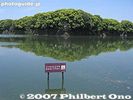
Corner of moat
|
|
|

Sakuradamon Gate 桜田門
|
|

Sakuradamon Gate, near here was where Lord Ii Naosuke from Hikone was assassinated. 桜田門
|
|

Sakuradamon Gate 桜田門
|
|

Sakuradamon Gate 桜田門
|
|

Sakuradamon Gate
|
|

Sakuradamon Gate
|
|

Sakuradamon Gate, rear view
|
|
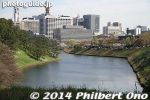
Sakurada Moat
|
|
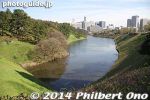
Sakurada Moat
|
|

Hanzomon Gate is guarded. This is the closest gate to the Emperor's residence. This is where they normally enter and leave the palace.
|
|
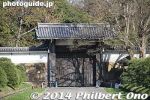
Hanzomon Gate, Imperial Palace, Tokyo
|
|
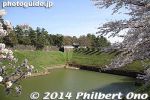
Hanzomon Gate
|
|
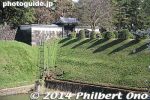
Hanzomon Gate
|
|

Hanzo Moat with Hanzomon Gate in the distance.
|
|
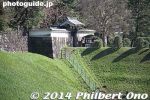
Hanzomon Gate
|
|
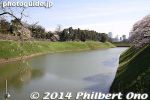
Hanzo Moat, near Hanzomon Gate.
|
|
|
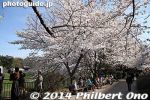
Cherry blossoms along Hanzo Moat.
|
|
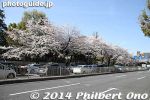
Cherry blossoms in front of British Embassy near Hanzomon.
|
|
|
|
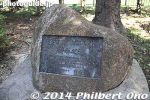
Marker for an old high school.
|
|
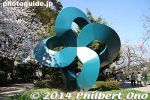
Mexican monument
|
|
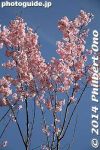
Maihime cherry blossoms 舞姫
|
|
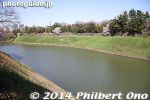
Hanzo Moat
|
|
|
|
|
|
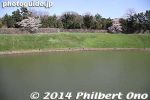
Hanzo Moat, near Hanzomon Gate.
|
|
|
|
|

Chidorigafuchi
|
|

Chidorigafuchi 千鳥ヶ淵
|
|

Chidorigafuchi with the roof of Budokan visible.
|
|
|
|
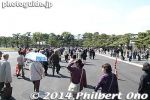
For the first time, they allowed the public to enter the Imperial Palace to view cherry blossoms along a short path called Inui-dori during April 4-8, 2014.
|
|
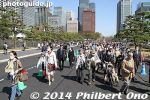
What happened was, tens of thousands of people showed up. On the first day April 4, 2014, over 55,000 people came to see the Inui-dori sakura.
|
|

People waited 2-3 hours to get in and underwent body searches. I arrived at 2 pm and it was too late to get in.
|
|
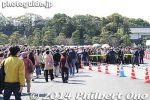
Insane crowds at Imperial Palace on April 4, 2014.
|
|

It was worse during the weekend.
|
|
|
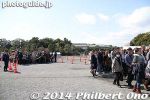
A total of 360,000 people visited Inui-dori during the period it was open to the public.
|
|
|
|
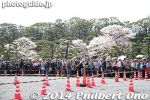
They plan to open Inui-dori to the public again in autumn for the fall leaves.
|
|

East Gardens of the Imperial Palace 皇居東御苑
|
|

Suwa-no-Chaya Teahouse 諏訪の茶屋
|
|

Suwa-no-Chaya Teahouse 諏訪の茶屋
|
|
|

Prefectural trees from all prefectures 都道府県の木
|
|

Miyazaki Prefecture's official tree 都道府県の木(宮崎県の木)
|
|

Ninomaru Garden 二の丸庭園
|
|

皇居東御苑
|
|

Ninomaru Garden in the East Gardens of the Imperial Palace
|
|
|

Ninomaru Garden
|
|
|
|

The Museum of the Imperial Collections (Sannomaru Shozokan), museum of Imperial Family gifts and artifacts. 三の丸尚蔵館
|
|
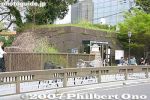
Remains of Ushigomi Mitsuke Gate along Sotobori Moat near Iidabashi Station.
|
|
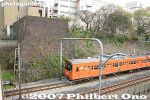
Remains of Ushigomi Mitsuke Gate along Sotobori Moat near Iidabashi Station.
|
|
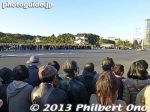
On Nov. 19, 2013, I took a friend around Tokyo and when we headed for the Imperial Palace, we saw this large crowd on the streets. Most were middle-aged and older people. The palace was closed off to tourists as well. Couldn’t see the famous Nijubashi Bridge.
|
|

I asked a bystander what was going on. She said they were waiting for “Caroline.” No mention of the last name. “Caroline” in Japan automatically means “Kennedy.”Although I always think of Neil Diamond’s song which coincidentally is about the Caroline they were waiting to see.
|
|

So I stuck around for about 15 min. and sure enough, at around 4 pm, her horse-drawn carriage appeared after she had shown her credentials to the emperor. I whipped out my camcorder and still camera and started shooting.
|
|

There were two horse-drawn carriages and I correctly assumed she was riding in the first one. No one waved Japanese and American flags though.
|
|

Fortunately, she was sitting on the right side of the carriage facing my side of the street. You can see her in this photo. Wish she waved to us. As soon as she passed, the crowd dissipated.We haven’t had such a star ambassador to Japan in a long time, not perhaps since Edwin Reischauer in 1960s or the beloved Mike Mansfield in the 1980s. Welcome to Japan, Sweet Caroline!
|
|
|
|
|